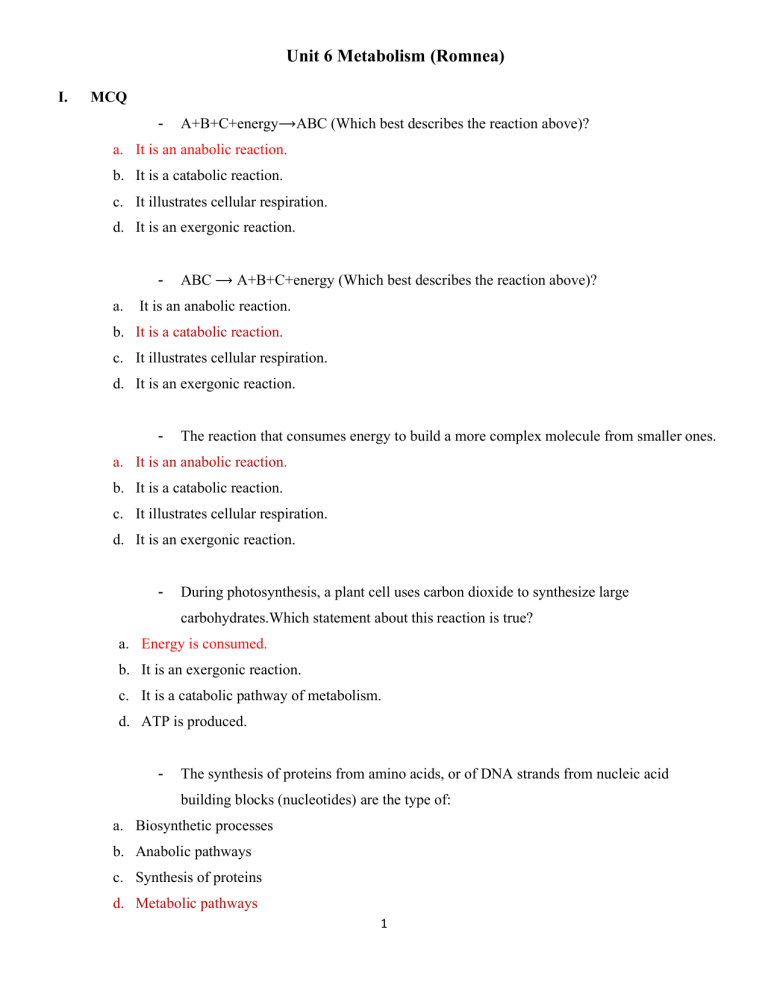Which Best Describes a Catabolic Reaction
The energy is used to produce carbohydrates. It fuels catabolic reactions.

Solved Correct Question 3 0 0 2 Which Of The Following Chegg Com
The anabolic process is the complete opposite of catabolism as it involves creating bigger complex molecules from smaller simpler molecules.

. It illustrates cellular respiration. The reaction that converts glucose to glucose-6-phosphate in glycolysis. Conversion of glucose to carbon dioxide and water in respiration.
Which best describes the energy of activation. C formation of sugar. 52 It is important to ensure that your diet is adequately rich.
A-They are exergonic reactions that build large macromolecules from smaller building blocks. B-They are endergonic reactions that break down large macromolecules into their. Our metabolic reactions that result in the breakdown of molecules often in in term often uh cata public is often used in nutrition description so the breakdown of lipids into fatty assets and the breakdown of proteins into amino acids.
These reactions release energy as the energy stored in the bond is released when broken down and is an exergonic reaction. It is a catabolic reaction. 51 Glycolysis is best defined as a catabolic reaction based upon the ________.
Which of the following describes catabolic reactions. Correct Question 3 002 Which of the following statements best describes catabolic pathways. B conversion of pyruvic acid into carbon dioxide and water.
A type of exergonic reaction b. So Cata bolic reactions tend to release energy and then lastly decomposition. Catabolism is the breakdown of complex molecules into simpler ones.
An example is the process of digestion is a catabolic process. Which of the following describes a catabolic reaction. It decreases entropy within the system.
Anabolism is the synthesis of complex molecules from simpler ones. The catalysts needed to raise a reactions rate. These chemical reactions may be linked into pathways.
These chemical reactions require energy. ATP hydrolysis is the catabolic reaction process by which chemical energy that has been stored in the high-energy phosphoanhydride bonds in adenosine triphosphate ATP is released by splitting these bonds for example in muscles by producing work in the form of mechanical energy. A type of endergonic reaction c.
It is an anabolic reaction. They are endergonic and release energy that can be used for cellular work. ABCenergy ABC Which best describes the reaction above.
These reactions release energy. ABCenergy ABC Which best describes the reaction above. A reaction that converts pyruvate to acetyl CoA with the release of carbon dioxide B.
They are exergonic and provide energy that can be used to produce ATP from ADP and or They require energy from ATP hydrolysis to break down polymers into monomers. The energy required for a reaction to proceed by breaking bonds d. What is a catabolic reaction.
It is an anabolic reaction. An optional reaction that transports pyruvate into the mitochondrion D. It is an exergonic reaction.
It is an exergonic reaction. Catabolism at its core involves breaking down of complex molecules and releasing energy for the body to use. D conversion of glucose into two molecules of pyruvic acid.
A series of reactions that convert citric acid to oxaloacetate C. The energy required for a reaction to proceed by breaking bonds. Which best describes the effect of inputting energy into a living system.
Which of the following statements best characterizes anabolic and catabolic pathways. Metabolism is considered to be the total chemical reactions occurring within an organism. In catabolic reaction is the reaction breakdown of large molecules is happens and energy is released.
Catabolic and Anabolic processes are required for the proper functioning of the body. Anabolic and catabolic pathways typically work together with the energy from catabolism providing the energy for anabolism. A small glucose molecules are linked together to form a larger molecule like starch b molecules of iron combine with oxygen giving up electrons and forming iron oxide rust c large protein molecules are broken down into smaller amino acids during digestion.
The best describe option for the reaction AB ABenergy is Its a catabolic reaction. Catabolic reactions are metabolic reactions which involves the breakdown of complex molecules into simpler ones. The molecules such as glucose protein carbohydrates.
Catabolic reactions break down molecules and release energy by braking down complex molecules to simpler compounds. A conversion of glucose into carbon dioxide and water. Anabolic pathways break down molecules while catabolic pathways synthesize molecules b.

Solved 1 Which Of The Following Best Describes The Chegg Com

Question Video Differentiating Between Anabolic And Catabolic Reactions Concerning Proteins And Amino Acids Nagwa

Comments
Post a Comment